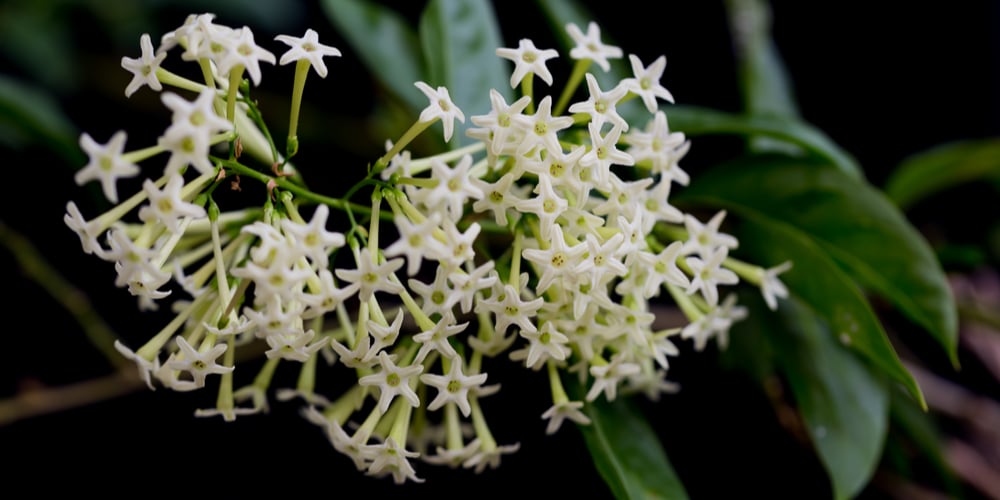If you’re looking for a beautiful and exotic plant to grow in your garden, the night-blooming jasmine (Raat rani) is a perfect choice. This graceful vine produces delicate white flowers that bloom in the evening, filling the air with their sweet fragrance.
In this guide, we’ll show you how to care for night-blooming jasmine so you can enjoy its beauty and fragrance all year long.
What is Night-blooming jasmine (Raat rani plant)?
Night-blooming jasmine (Raat rani plant) is an evergreen perennial that’s fast-growing and can be used in various landscaping projects. It’s native to southeast Asia and is also found growing across Oceania. These plants are part of the Oleaceae botanical family, consisting of over 200 plants.
Its fragrant flowers bloom at night, giving it the name “night-blooming jasmine.” The flowers are followed by tiny rounded berries that are white and full of seeds. These plants commonly grow in forested areas and are traditionally used in Ayurvedic medicine. It’s a fast grower and can quickly climb to 6 or more feet if allowed.
How to care for Night-blooming jasmine (Raat rani plant)?
Although night-blooming jasmine can be grown indoors or outdoors, it’s best to grow your plant indoors if you live in an area with cool nights, such as the northern USA or Canada.
Containers will restrict its growth so it won’t reach its full potential, but you can prolong the growing season by putting your plant near a sunny window.
The night-blooming jasmine is a versatile plant that can also be grown outdoors as a hedge, vine, or planted in a flower bed. Here are some tips to help you care for a raat rani plant:
Soil
Use good quality potting soil and mix in some sand and gravel or orchard bark to ensure good drainage. Night-blooming jasmine thrives in soil with a neutral pH range of between 6.6 and 7.5.
Watering needs
Water regularly and fertilize 2 to 3 times a year with an all-purpose fertilizer.
Sunlight
Place your indoor night-blooming jasmine in a bright spot near a sunny window, but not directly in the sun. Plant in partial to full sun outdoors, depending on your climate. Most plants prefer the full sun, but if you live in warmer climates where the plant will be exposed to afternoon heat, provide some afternoon shade.
Temperature
Night-blooming jasmine can be grown outdoors in USDA zones 6 to 10. Plant in spring after all danger of frost passes.
In colder climates, to protect the vines from damage due to cold winter winds, support your plant with a sturdy structure and wrap it in insulating materials such as burlap or spun polyester from late fall until early spring.
Propagation
Propagating night-blooming jasmine is easy. You can start new plants by rooting stem cuttings in water or potting soil, or take cuttings of existing vines and place them directly into the garden after all chance of frost has passed.
Pruning
Prune back your night-blooming jasmine as often as needed during winter to maintain its shape and encourage it to produce blooms. You can train the vines onto supports made of stakes, trellises, or wire for a beautiful display.
Pests and diseases
Several common pests can affect night-blooming jasmine, including cutworms, caterpillars, mealybugs, and spider mites. Because mealybugs are likely to spread plant diseases, it’s best to get rid of them quickly by wiping leaves that show signs of infestation.
You can control spider mites with a strong spray of water or use an insecticidal soap spray on the undersides of leaves if necessary.
If you suspect your plant has root rot, cut back on watering and monitor the plant closely for a few weeks. If you don’t see any improvement, replant your vine in a new location with well-draining soil. Cut off any roots that look black and infected and treat the healthy roots with a fungicide before replanting.
Night-blooming jasmine (raat rani plant): Conclusion
Night-blooming jasmine (Raat rani plant) is a versatile vine that attracts hummingbirds and butterflies to the garden. It’s an evergreen perennial that does well in various climates.
Night-blooming jasmine (Raat rani plant) care is easy and pretty much carefree once your plants are established. Keep them well-watered during the first summer to help develop deep roots, but regular watering will be sufficient after that.
You may also be interested in: Sugar Vine Plant

